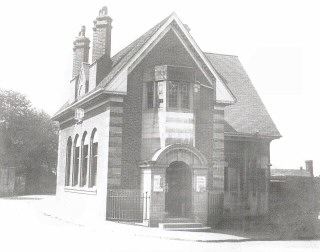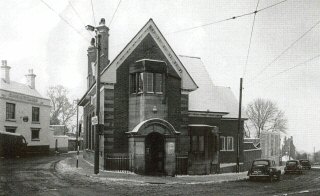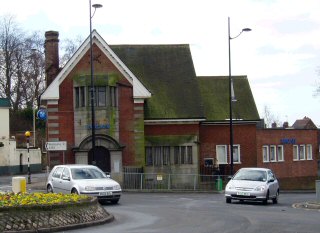The bank is situated on the
west side of the Bull Ring on a tight triangular site bordered by Gospel End
Street and Ettymore Road. In the late
C19th the land, which belonged to the Earl of Dudley, was described as
containing three cottages, a barn, nail shop, garden and a disused malt house,
and in 1897 was occupied by a George Bradley and his under-tenants. In December 1897 the freehold then passed to
the trustees of the late Richard Homer and around the turn of the century the
Homer family built a new hall for the temperance movement on part of the
land. A few years later, on October 9th
1907, John Twigg Homer sold the freehold to the United Counties Bank
Limited.
This bank, under the name of
the Birmingham District and Counties Bank, had opened a branch somewhere in Dudley
Road on March 27th 1899. The move to the newly built bank at 9 Bull Ring took place in 1909. The manager, William Greenhill,
was treasurer to Sedgley & Coseley Urban District Councils.
In 1916 a banking
amalgamation saw Barclays Bank Limited acquire the United Counties Bank
premises at the 1909 value of £2,393-11-7.
There were three members of staff – J. S. Hilton, Clerk in Charge and an
employee since 1899, E. T. Whitworth and H. G. Hill. Respectively, their ages and annual earning were – 42 years,
£220pa, 18 years, £45pa, and 19 years, £40pa.
It is likely the two youngsters were relief staff covering for those on
military service in the First World War.
In 1940 Barclays house
magazine, ‘The Spread Eagle’, reported James A. Wright’s retirement as Manager
and H.J. Jones’s promotion to the post after being Chief Clerk at Sedgley
for fifteen years.
Since the Second World War the branch
has been extended and regularly refurbished to meet the banking demands of the
area, yet it’s outward appearance onto the Bull Ring is almost unaltered. In 1983 a major initiative saw more
alterations and a new management suite [no longer in existence] opened at 29
Dudley Street. Tony Davies was Branch
Manager at this time.
The top photograph, circa
1920, shows steps leading into the bank while the early 1960s winter scene shows
the branch with a quite recently added extension. Note the supporting columns and wires that carried the overhead
power supply for the trolley bus era – 1927 to 1967. The latest views, taken in February 2004, show a further extension
from the 1980s and emphasize how pavement and road levels have risen over the years.
[Additional material
provided by the Group Archives Unit of Barclays Bank PLC and black & white
photographs © Barclays Bank PLC]




